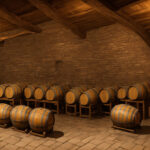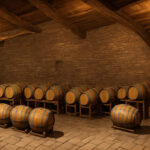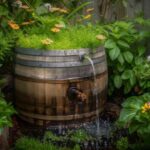Ever wonder how the type of barrel influences a whiskey’s flavor? It’s a question whiskey lovers ponder all the time. The big debate is: new charred oak barrels or used ones? If you’re a whiskey fan, you owe it to yourself to understand how barrel choice shapes the taste of your drink.
Let’s settle this, or at least have some fun trying. We’re going to do a completely unscientific but hopefully entertaining taste test, comparing whiskeys aged in new barrels against those aged in used ones. The results might just surprise you. But before we get to the tasting, let’s talk about how barrel aging works and why new and used barrels create such different flavor profiles. By the time you finish this, you’ll be the most knowledgeable whiskey enthusiast at your favorite bar.
The Great Whiskey Barrel Debate: New vs. Used
The discussion about new versus used oak barrels for aging whiskey is an old one. If you’ve tasted different whiskeys, you’ve probably already noticed a difference and have your own preference. New charred oak barrels, all fresh and toasty, give the whiskey more oaky flavors and aromas. Used barrels, having already aged another spirit (like bourbon), contribute softer oak notes and let the whiskey’s inherent flavors shine through.
The Case for New Oak Barrels
Think of new oak barrels as a brand new set of paints – they’re ready to make a statement. The charred inside of a new barrel releases vanillin and other compounds that give whiskey those delicious vanilla and coconut scents. Tannins from the wood also smooth things out and give the whiskey a nice, rounded feel in your mouth. Many distillers, especially those making top-shelf single malts, use new oak barrels to create a bold, oak-forward flavor.
The Case for Used Oak Barrels
Used barrels have already been through the aging process, so they’re a bit more mellow. They allow the whiskey’s natural malty and fruity flavors to come through because the wood notes are less intense. Used barrels can also speed up aging a bit since the wood is already porous. The previous spirit that soaked into the wood can even add some complementary flavors. A lot of distillers use used barrels to get a complex, balanced flavor without too much oak.
Ultimately, whether you like new oak or used barrels is a matter of personal taste. Both make great whiskeys with their own unique flavors. Next time you’re at the bar, try a side-by-side comparison – you might just find a new favorite.
The Science of Whiskey Barrel Aging
Aging is what gives whiskey its color and flavor. New charred oak barrels are often used, adding vanilla and spice. But used barrels can create some interesting surprises.
Let’s break down the science:
- Extraction: Whiskey pulls out compounds from the wood, like lignin, tannins, and hemicellulose. Chemical reactions happen as the whiskey interacts with the barrel.
- Penetration: Alcohol and water go into the wood, extracting flavors. The longer it ages, the deeper it goes.
- Oxidation: Oxygen gets in and out of the barrel through the wood’s pores. This helps the whiskey’s aroma and flavor develop. Too much oxygen is bad, so barrels are chosen carefully.
- Evaporation: Some of the whiskey evaporates. This is called the “angel’s share” and can be a significant amount over time. What’s left becomes more concentrated in flavor.
- Temperature Fluctuations: Changes in temperature make the barrel expand and contract, which pushes more flavor compounds into the whiskey. This back and forth adds to the complexity.
- Used Barrels: Used barrels add another layer of variety. Since they’ve already aged another spirit, they can contribute extra flavors – maybe something nutty, spicy, or fruity. Each used barrel is different, making for more diverse and unique flavors.
The science of barrel aging is complicated, but the results are fantastic. Whether the barrels are new or used, they transform raw distillate into the whiskey we enjoy. Next time you sip some aged whiskey, think about the craftsmanship and patience that went into making it.
New Oak Barrels: The Pros and Cons
New and used oak barrels both have their advantages and disadvantages. Here’s a quick look:
New Oak Barrels: The Good
- More Oak Flavor: New barrels have more of those oaky compounds, like vanillin and lignin, which give the whiskey strong vanilla, caramel, and spice notes.
- Faster Aging: The wood in new barrels is more porous, so the whiskey interacts with it more. This speeds up the aging.
- Unique Flavor: Every time a barrel is used, it creates a slightly different flavor. New barrels mean a completely new experience.
New Oak Barrels: The Not-So-Good
- More Expensive: New oak barrels cost a lot more than used ones, which makes production more expensive.
- Can Be Overpowering: The strong oak notes from new barrels can sometimes hide the more delicate flavors of the whiskey. It takes time for the oakiness to mellow out.
- Unpredictable: Because each new barrel ages whiskey differently, it’s hard to predict exactly what the flavor will be. This can be tricky for big companies that need consistency.
While new oak barrels give whiskey a unique, first-time flavor, used barrels offer a softer oak character and a more subtle interaction with the spirit. Most distillers use a mix of new and used barrels to get the right balance of wood influence. Ultimately, it’s all about personal taste and the style of whiskey the distiller is aiming for.
Used Bourbon Barrels: The Pros and Cons
Used bourbon barrels (sometimes called “second-use” barrels) also have their own set of pros and cons.
Used Bourbon Barrels: The Good
- Softer Oak Flavors: Used barrels give the whiskey more subtle oak flavors. The wood has already been used once, so it won’t overwhelm the whiskey with oak tannins and vanillins. This helps the whiskey develop richer, more complex flavors.
- Cost-Effective: Used bourbon barrels are cheaper than new ones. Distilleries can save money by reusing barrels.
- Traditional: Some distillers use used barrels to stick to traditional methods. It’s how things were done historically.
- Environmentally Friendly: Reusing barrels means less oak needs to be harvested.
Used Bourbon Barrels: The Not-So-Good
- More Oxidation: Used barrels might leak more air, which can cause more oxidation and evaporation. This means you might lose more whiskey to the “angel’s share.”
- Faster Aging: More air exposure can make the whiskey age faster, which gives you less control over the process.
- Shorter Lifespan: Used barrels don’t last as long as new ones. They might need to be replaced after a few uses.
Whether you prefer new or used barrels depends on your taste and what you value. Both options make delicious whiskey with unique characteristics. The best way to figure out what you like is to try whiskeys aged in both types of barrels.
How Barrel Type Changes Whiskey Flavor
The type of barrel has a huge impact on a whiskey’s flavor. New charred oak barrels (often American white oak) are commonly used for bourbon. The charring makes the wood taste like caramel, adding those notes to the whiskey. Bourbon aged in new barrels tends to be oaky and strong.
Used barrels, especially those that held wine or sherry, usually create a whiskey with softer oak flavors and hints of the previous contents. For example, whiskey aged in used port or sherry casks might have raisin or nutty aromas. Used barrels also let the whiskey interact with the wood more, which makes for a more complex flavor.
Blending Barrel Types
Some distilleries use a mix of new and used barrels to get a nice balance of flavors. The new barrels give it oaky and spicy notes, while the used ones add dried fruit and nut aromas. By blending whiskeys from different barrels, the distiller can create a smooth, multi-dimensional spirit.
Experimenting With Barrels
A few craft distilleries are trying out new and interesting barrel types to create unique flavors. Port, rum, and tequila casks are being used to finish some whiskeys, which can add tropical, molasses, or agave notes. You might even find whiskeys aged in barrels that previously held maple syrup, stout beer, or peated Scotch.
While new charred oak barrels will probably stick around for most big whiskey brands (because of tradition and cost), the rise of craft distilling is bringing a lot of exciting variety to the world of whiskey barrels and flavors. Trying whiskeys aged in different types of barrels is a great way to explore how much the wood and what it held before can change a spirit. Comparing a classic bourbon to one finished in rum casks or stout barrels can really open your eyes to the art of barrel aging and blending.
Key Flavor Differences: New vs. Used Barrels
New oak barrels give the whiskey a much stronger oak flavor. The wood is more porous, so more of the whiskey soaks up those oaky compounds. You’ll definitely taste more vanilla, caramel, and spice.
Used barrels have already aged another spirit, so the wood has less oak flavor to give. Whiskeys aged in used barrels tend to have softer wood notes, and the original spirit’s character comes through more.
Here’s a breakdown:
- Oak Intensity: New barrels give you a big hit of oak tannins, lactones, and wood sugars. Think clove, nutmeg and burnt sugar. Whiskey from used barrels has a much softer oak presence. The wood flavors are more integrated, letting the natural grain and malt flavors shine.
- Sweetness: Whiskey aged in new barrels often tastes sweeter because of the compounds extracted from the oak. You might notice flavors like maple syrup, honey, and brown sugar. Whiskey aged in used barrels tends to be spicier and less sweet, with the grain and malt flavors being more prominent.
- Finish: The finish is the taste that lingers after you swallow. Whiskey from new oak barrels usually has a longer, warmer finish because of the oak compounds. Used barrel whiskey typically has a shorter finish, with the malt, grain, and subtle wood flavors fading more quickly.
Whether you prefer the strong oak and sweetness of new barrels or the mellow, grain-forward flavors of used barrels is all about what you like. Whiskey lovers can debate this all day, but you can’t really go wrong either way.
Notable Whiskey Brands and Their Barrel Choices
Distillers can choose between new charred oak barrels and used barrels (often those that previously held bourbon). Both options create well-known brands with distinct flavors.
- Maker’s Mark: This popular bourbon uses only new, charred white oak barrels. The fresh barrels give it oaky vanilla and caramel notes, along with a subtle smoky char flavor. Maker’s Mark is a wheated bourbon, which means it uses wheat instead of rye as the second grain. This makes it a bit sweeter and softer, which goes well with the new oak barrels.
- Buffalo Trace: Buffalo Trace makes several bourbons aged in used barrels, including Eagle Rare, Stagg Jr., and George T. Stagg. The used barrels create a whiskey with more mature, complex flavors like dried fruit, nuts, and leather. Buffalo Trace is known for their experimental collection where they age the same whiskey in new and used barrels side by side to show the differences. Bourbon fans often like the extra richness and depth of flavor from used barrel aging.
- Four Roses: Four Roses uses a mix of new and used barrels for their bourbons. Their standard yellow label bourbon combines whiskeys from all 10 of their unique yeast strains and mash bills, some aged in new oak and some in used. This balanced approach makes for a mellow, easy-drinking bourbon with both oaky and rich fruity notes at a good price. For their small batch and single barrel bourbons, Four Roses hand-picks barrels (again, a mix of new and used) for the best flavor.
Whether new or used, charred oak barrels are essential for aging bourbon and adding unique flavors. Both types of barrels have created well-known brands that people love. Trying a mix of both might be the best way to experience everything bourbon has to offer.
Best Practices for Barrel Management
Once you have your whiskey barrels, keeping them in good condition is vital for making quality whiskey. Here are some best practices:
- Cleaning: Before you fill barrels with whiskey, clean them well to get rid of any leftover residue. Rinse them with hot water and a mild detergent, then rinse again with just hot water. Let the barrels dry completely to prevent mold or bacteria.
- Filling: Don’t overfill the barrels. Leave some empty space (called “headspace”) at the top. This gives the whiskey room to expand as it ages. A good rule of thumb is to fill bourbon barrels about two-thirds full and Scotch barrels about three-quarters full.
- Rotation: As whiskey ages, the barrels absorb and add flavor compounds. To make sure the aging is even, rotate your barrels regularly. Roll them on their sides and turn them upside down to change the position of the top and bottom. This helps the whiskey interact with the whole inside surface of the barrel.
- Checking for Leaks: Small leaks can develop in barrels over time as the wood expands and contracts. Regularly check for any drips, especially in the first year. Small leaks can often be fixed by lightly sanding and re-charring the area. Larger leaks might need you to re-wax the whole barrel. Leaky barrels will lose a lot of whiskey, so repairs are important.
- Maintaining Humidity: The humidity in your aging warehouse affects how quickly the whiskey ages. Higher humidity makes whiskey age faster, while lower humidity slows it down. Keep an eye on the humidity and adjust it as needed. Most distilleries aim for 65-80% relative humidity.
Good barrel management takes time and attention. But when done right, it lets you create a spirit that shows off the qualities of the wood and your distilling style. The extra effort will result in a whiskey worth savoring for years to come.
FAQs on Whiskey Barrel Aging
Aging whiskey in barrels is an art. Here are some frequently asked questions:
How does barrel aging work?
Barrel aging lets whiskey develop complex flavors through oxidation. As whiskey sits in charred oak barrels, it absorbs compounds from the wood (like vanillin) that give aged whiskey its distinctive taste. The whiskey also loses some volume to evaporation, which makes the flavor more concentrated.
What’s the difference between new and used barrels?
New charred oak barrels give the whiskey more oak flavor. Bourbon has to be aged in new charred oak barrels. Used barrels have already been through one aging cycle, so they add more subtle oak notes and let the original distillate flavor come through. Many distillers use a mix of new and used barrels to balance oakiness and spirit character.
Does barrel aging make all whiskeys better?
Barrel aging works best for whiskeys with a strong, flavorful distillate that can handle the oak, like bourbon. Light or neutral spirits won’t benefit as much. The quality and type of oak also matter. American white oak and French Limousin oak are popular choices.
How long should whiskey age?
There’s no set time. Bourbon has to age for at least 2 years, but most premium bourbons age for 4-12 years. Scotch and Canadian whiskies often age longer, sometimes up to 18-25 years for premium brands. A whiskey should be aged until it reaches its peak maturity and complexity. This depends on the distiller’s skill and personal taste.
Does whiskey continue to age in the bottle?
No. Once it’s bottled, whiskey stops aging. Oxidation and evaporation need contact with oak barrels. If an unopened bottle is stored properly, its flavor will stay stable for many years. But once it’s open, whiskey can start to oxidize and lose quality within 6-12 months.
Final Thoughts
So, there you have it. A deep dive into new versus used whiskey barrels and how they affect the aging process. New charred oak barrels give stronger wood flavors that fade over time, while used barrels produce a mellower, more complex taste. It all comes down to what you prefer. Some like the bold flavors of a new barrel, while others prefer the more subtle notes of a used cask. The good news is, you can’t really go wrong. Whiskey is meant to be enjoyed. Pour yourself a glass of each and see which one you like best. The differences might be subtle, but that’s what makes becoming a whiskey connoisseur so much fun.




